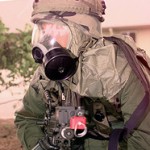Bruce Groves
Why do we care about particles floating around in our air? Small, inhalable particles are themselves
pollutants that have shown to cause illness and chronic diseases such as asthma and
certain types of lung cancer . Particles are also excellent indicators (or surrogates) for measuring other pollutants such as vapors and gases. By measuring the aerodynamic size of particles in our air, it is possible to identify and sometimes fingerprint them so that we can reduce or stop local sources of pollution immediately. The goal AND end result are to develop as clean a living and working area as possible.
What are we doing today?
Today, air monitoring is a piecemeal approach that is government-mandated but generally project related. When the project is over, the problem is essentially considered to be gone. Of course, in areas of high population density or industrial activity, continuous, real-time air monitoring of general conditions does not exist. Other than pollen counts, very little information about these pockets of high pollution and high particulates is available to the public or government agencies. And, the data that is available is generally much later and does not present an accurate picture of todays problem.
What is the future in environmental air monitoring?
As technology has improved, so have particle detectors and the ease of data transmission and analysis. By 2013, small particle size detectors, such as those found in the Greenlight Environmental Monitoring System, will be consistently deployed in high population areas in such cities such as NYC, Tokyo, London and Los Angeles. These particle size detectors will be coupled with wind-speed and direction detectors and web cameras to pinpoint the exact sources of particle emissions (e.g., construction or industrial equipment, idling vehicles or high traffic transportation corridors) that are creating a measurable increase in local air pollution.
This web of detector stations will form an active or live map of a city that continuously measures and reports the concentration of various particle sizes. The map will be automatically programmed to provide warning levels and alarms to reveal when and where total particle concentrations exceed warning and safe threshold levels. By locating (in real time) the place, the direction of the pollution source and supporting video evidence, private companies and government agencies can take measures to stop or reduce the indicated pollution sources. Constant real-time monitoring, assessment and action will provide continuous improvement in local air quality that will reduce the onset of disease associated with inhaling dirty air. Warning systems set up through websites will enable agencies and individuals to check on their local air pollution conditions using their computer or smart phone.
What is the first step?
At Emilcott, we have been working with particulate monitoring on job sites for over 25 years. As an extension of our field experience, were working on a solution that meets the needs of our clients (private companies and government agencies) -- the
Greenlight Environmental Monitoring System. With multiple project implementations under its belt, the Greenlight Systems particle size measurement, assessment and reporting capabilities are demonstrating how real-time monitoring is helping projects get cleaner each day reducing the liabilities of our clients while giving them the information to keep the public and workers safe.
As the Greenlight Systems next phase of engineering development is outlined, our goal is to have a universal system that will provide comprehensive sampling in potentially high pollution areas so that neighborhood air quality can be improved and the incidence of lung disease is reduced. It will be a future watchdog for providing cleaner air locally where no such means of protecting local air quality exists today.
What do you think the future of environmental air monitoring holds? What are the benefits or challenges that you associate with monitoring and mapping pollutants in a broad geographic area?









